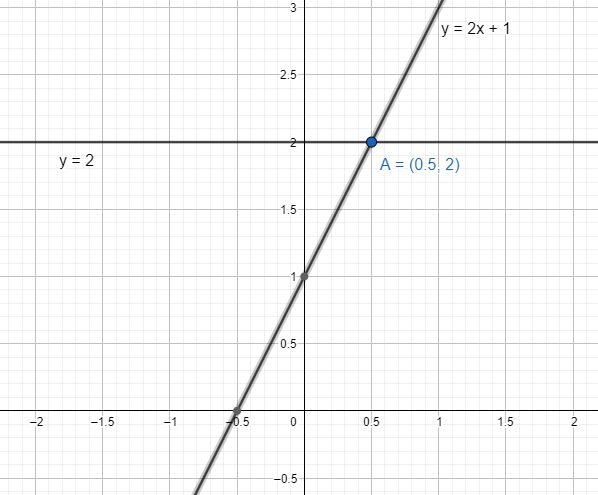Answer
384.3k+ views
Hint: We first explain the relation of inverse function with its function types. We find if the function is one-one or not. We use horizontal line tests to determine whether the inverse of $f\left( x \right)$ is a function and find the function if it exists.
Complete step-by-step solution:
We need to find whether the function $f\left( x \right)=2x+1$ has an inverse or not through a horizontal line test. If it has an inverse then we find the inverse.
First, we find the characteristics of the function $f\left( x \right)=2x+1$. It is a one-one function.
This means for a particular value of $x$, we will get only one value of $y$.
So, every value of $x$ can be projected to a particular value of $y$.
In case of one-one function, we can have an inverse always irrespective of the function.
In case many-one functions, we can’t have an inverse function.
Let’s assume that $g\left( a \right)=g\left( b \right)=c$ for an arbitrary function $g\left( x \right)$.
This is a two-one function. The domain has two values $a,b$ that give the same value of $c$ in range. Condition is $a\ne b$.
When we are taking the inverse, we get one value $c$ in domain which gives two values $a,b$ in range. That can’t be function as ${{g}^{-1}}\left( c \right)=a$ and ${{g}^{-1}}\left( c \right)=b$ but $a\ne b$.
The horizontal line test gives that for the function $f\left( x \right)$ if any horizontal line represented as $y=k$ on infinite extension cuts the graph more than once then the graph can’t have an inverse function.
For $f\left( x \right)=2x+1$, we have inverse function. Let $y=2x+1$ which gives $x=\dfrac{y-1}{2}$.
Therefore, the inverse function is ${{f}^{-1}}\left( x \right)=\dfrac{x-1}{2}$.
We take a horizontal line represented as $y=2$. We draw the graphs of $f\left( x \right)=2x+1$ and $y=2$.
We find their intersection.

The only intersection is the point $A=\left( \dfrac{1}{2},2 \right)$. Therefore, the inverse of $f\left( x \right)$ exists.
Note: If the horizontal line intersects the graph of a function in all places at exactly one point, then the given function should have an inverse that is also a function. We say this function passes the horizontal line test.
Complete step-by-step solution:
We need to find whether the function $f\left( x \right)=2x+1$ has an inverse or not through a horizontal line test. If it has an inverse then we find the inverse.
First, we find the characteristics of the function $f\left( x \right)=2x+1$. It is a one-one function.
This means for a particular value of $x$, we will get only one value of $y$.
So, every value of $x$ can be projected to a particular value of $y$.
In case of one-one function, we can have an inverse always irrespective of the function.
In case many-one functions, we can’t have an inverse function.
Let’s assume that $g\left( a \right)=g\left( b \right)=c$ for an arbitrary function $g\left( x \right)$.
This is a two-one function. The domain has two values $a,b$ that give the same value of $c$ in range. Condition is $a\ne b$.
When we are taking the inverse, we get one value $c$ in domain which gives two values $a,b$ in range. That can’t be function as ${{g}^{-1}}\left( c \right)=a$ and ${{g}^{-1}}\left( c \right)=b$ but $a\ne b$.
The horizontal line test gives that for the function $f\left( x \right)$ if any horizontal line represented as $y=k$ on infinite extension cuts the graph more than once then the graph can’t have an inverse function.
For $f\left( x \right)=2x+1$, we have inverse function. Let $y=2x+1$ which gives $x=\dfrac{y-1}{2}$.
Therefore, the inverse function is ${{f}^{-1}}\left( x \right)=\dfrac{x-1}{2}$.
We take a horizontal line represented as $y=2$. We draw the graphs of $f\left( x \right)=2x+1$ and $y=2$.
We find their intersection.

The only intersection is the point $A=\left( \dfrac{1}{2},2 \right)$. Therefore, the inverse of $f\left( x \right)$ exists.
Note: If the horizontal line intersects the graph of a function in all places at exactly one point, then the given function should have an inverse that is also a function. We say this function passes the horizontal line test.
Recently Updated Pages
How many sigma and pi bonds are present in HCequiv class 11 chemistry CBSE

Why Are Noble Gases NonReactive class 11 chemistry CBSE

Let X and Y be the sets of all positive divisors of class 11 maths CBSE

Let x and y be 2 real numbers which satisfy the equations class 11 maths CBSE

Let x 4log 2sqrt 9k 1 + 7 and y dfrac132log 2sqrt5 class 11 maths CBSE

Let x22ax+b20 and x22bx+a20 be two equations Then the class 11 maths CBSE

Trending doubts
Fill the blanks with the suitable prepositions 1 The class 9 english CBSE

At which age domestication of animals started A Neolithic class 11 social science CBSE

Which are the Top 10 Largest Countries of the World?

Give 10 examples for herbs , shrubs , climbers , creepers

Difference between Prokaryotic cell and Eukaryotic class 11 biology CBSE

Difference Between Plant Cell and Animal Cell

Write a letter to the principal requesting him to grant class 10 english CBSE

Change the following sentences into negative and interrogative class 10 english CBSE

Fill in the blanks A 1 lakh ten thousand B 1 million class 9 maths CBSE



